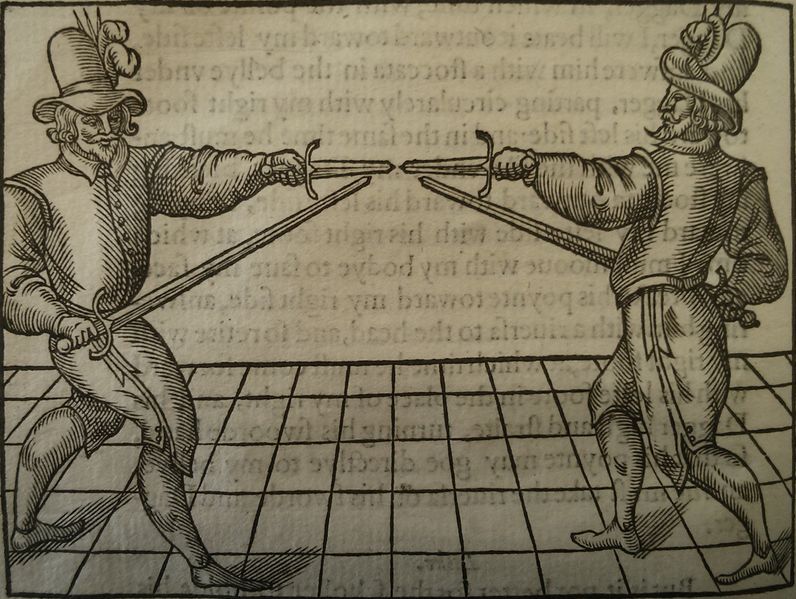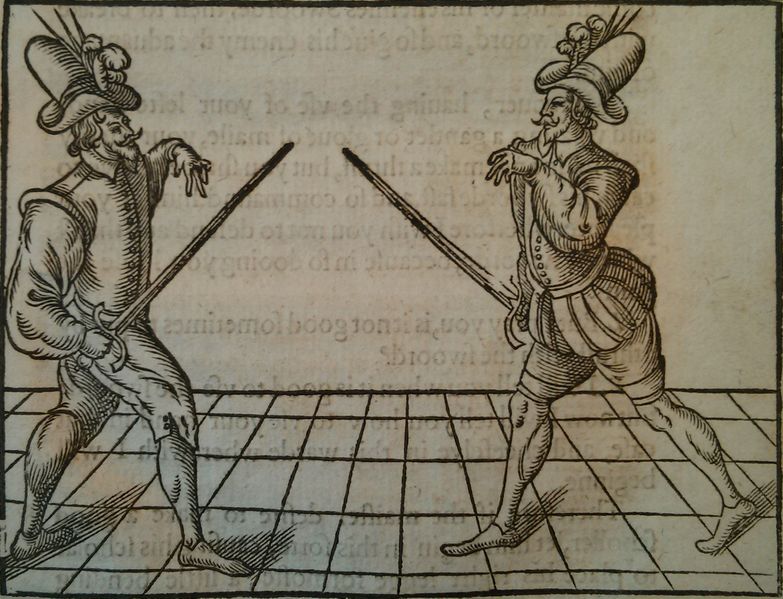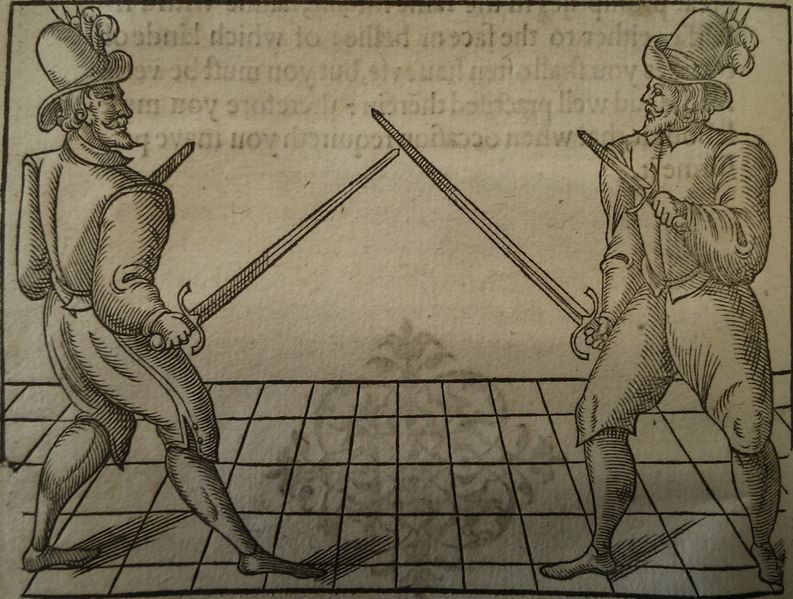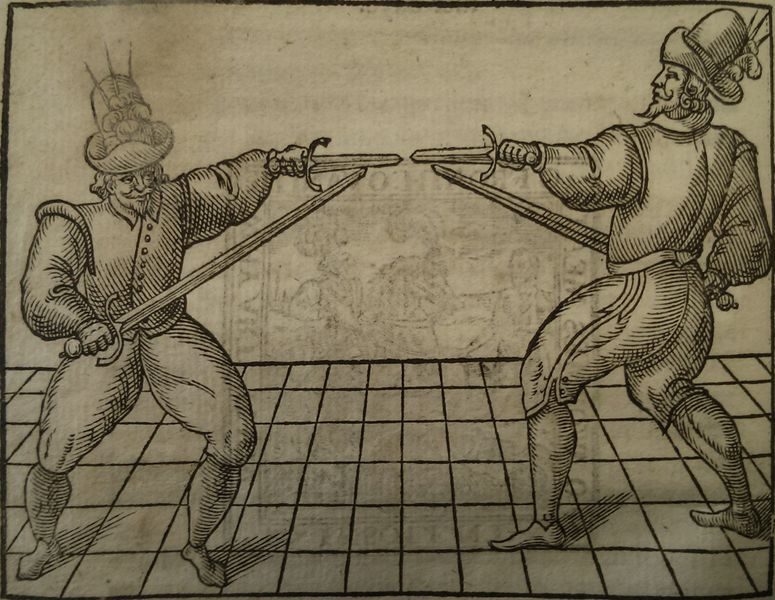PUTTING IT ALL TOGETHER
Up until now, you have been doing drills that get you familiar with distance, measure and movement. They have been light on attack and defense and have not covered use of the off hand. Now we can start to put everything together, and in doing, be able to add more to what is envisioned in this method.Each learning point used here is going to be layered like an onion. Each layer is a foundation for another. It all needs to be stacked together to be functional. or too long, the SCA approach has been to take a bit of what works here, and there; and try to put it to some use. It is kind of like a charm bracelet; each thing on it is different and might not be related to the other. It's chunky and might not work together as a whole. Instead, think of a historical method as a string of pearls that all theme together to work. The footwork needs to be solid, and theories need to be understood and it all works together and in concert with another.
This drill is done with full kit, at full speed combat. Initially this drill is being presented as a sword drill only (Spada DeFilo) but can be used with off hand weapons, off and, etc. You can refer to this drill whenever you adopt a new weapon, offhand thing, or want to learn how to defend against something.
So, let's start putting it together.
Close The Line.
Closing the line is found in many different manuals at the time. The dagger helps to close the line by pre-emptively closing the line, instead of the sword. The primary defense is supposed to be done with the dagger, if at all possible.
If just using a sword, Saviolo uses two basic positions to parry with. If there is a dagger involved, the is no difference with the use of the sword for closing the line. Just use the sword AND the dagger to close the line together.


Closing the line outside
Closing the line Inside
A lot like the onion again, we add layers to this in order to make it work. The bottom layer of the sword does exactly what it will do with or without the dagger. We just add the dagger into the mix, and not substitute the defense with the sword with that of the dagger. However, it will be the preference now that the dagger is added, to use it as a defensive option as much as possible. This frees the sword for offence, for what it was meant to do.
Three Tempo Drill
As usual, we have an Agent and a Patient. The Agent will start out of distance, and will have three tempo's to complete the attack, once it starts. The Patient, is limited to a static position, standing on their surest ward. The Patient is limited to closing the line, but is not able to move out of distance. The Agent is responsible for measure. Once the attack is started by the Agent, the Patient is free to use any counter and parry needed, and can only move a pace in one direction or another. The Patient must concentrate on
defense but can't pass out of measure. The Agent will have three tempo's to try and make a touch on the Patient. The Agent is not limited to any direction, distance or tactic
to win, the Patient must survive the pass/make a touch on the Agent; and the agent must make a touch in three tempos. The Patient can't leave the fight, and the Agent must think it out.
Start with an Agent and a Patient
-Agent starts out of measure
-Patient stands on surest ward
-Agent steals measure using any if the footwork previously covered
-Patent must remain static and can only close the line (offering a counter)
-Agent plans out an attack
-Agent launches attack when ready, and has only three tempos
-Patient has no restriction on tempo, but can't actively react until first attacked
-Do 10 passes and then switch
Points: Like the rest of the drills we use here, both roles have very important learning points. The patient is going to have to deal with defense, and must think mainly of defense. The Agent has to figure out how to crack the nut in three tempos.
Attack Suggestions;
Constant Contact Drill
This drill is my personal favorite. You will need your full kit, mask, gloves, etc. The goal is to make a touch to the opponent, without ever taking your blade off the other. This means that in an ideal setting, there will be no
off line attacks made against the opponent. If you simply cannot make your touch while also controlling the other blade, you lose. Also, don't practice this drill with the use of the off hand. You should learn to be 100% proficient with the sword before ever taking up an additional thing to use.
Start this drill around middle measure with tips menacing and the blades crossed by about 3 inches. There is no Agent or Patient for this drill. You each try to make a touch to the body or head without losing contact of the other sword. You can disengage, provided that you only re-engage the blade. You can take the blade off the other one to make your touch, as long as your hilt or the blade has locked out and prevented a counter attack from the opponent. You can also use an effective parry that moves the other blade
off line as long as you cover the others blade when you make your touch.
When doing this drill, you must not allow yourself to double kill. You should not use a faster reaction speed to power a shot in, or to hit the opponent off line, or to do a pass and hit them from the flank. This is not a gun slinger drill. This drill will wear you out, but teach you to "Feel" the opponent's blade and feel how yours behaves. Each blade is different, as well as the body holding that blade and this is a good drill to learn the limitations and benefits. For the touch to be valid, the opponent's blade must be controlled or there must be a controlling contact, blade to blade.
Like the tactics drill above, you can come back with offhand weapons, or shields, and the like to use with this drill, but start it without an offhand.
Two fighters start in middle measure
-Blades are extended and touching
-Fighters move to counter and close lines as needed, always trying to gain control
-Cravatsion, beat or anything else
-Defense is the first consideration
-Contact or control must be maintained in order to "Win"
-When a touch is made, reset
-Do for 10 min
Points: The Constant Contact Drill is also a conditioning drill. If done right, it is a bit of a workout on the arm. That is a secondary intent. The primary intent is to be able to understand how to react to the opponent’s blade by feel. This is a completely invented fencing drill. It is an SCAism, and fights may end up in extended binds, and you will need to know how to get out of them.
OK, so now that we have talked about what it is, WHAT DID IT LOOK LIKE?



Actions:
-Right circle pace step
-Re-assemble to right lead
-Stoccotta in terza
-Body void, offhand control to right
-Right remove + roverso
-Thrust to counter riverso, go to guardia defacia
-"Break thrust to left"
-Remove left foot, cut a dritto and thrust a stoccata
-Go to "High Ward" defending the stoccata. This may be the so called Universal Parry
-Right compas step +
stoccata and beat left
Thrust imbroccata in counter time
-Beat left + fendente
-Incartata, and gurardia defacia
-Right compass remove + stoccata
-Body void + right beat + right remove
-Side step as much as possible
-Remove to side, compass like
-Imbroccata like a stoccata
-Advice: With an opponent that presents a long stance, hand parry and do a left remove
-Advice: Defend a roverso with a guardia alicorno, and from
that guard hand parry and cut a roverso
 This one is from Saviolo's Second Ward. I should talk about the wards, as being different than the positions. The things such as low extended ward, first, second and third positions; etc. are not the wards in and among themselves. Saviolo's
wards are more like ideals of how to approach the fight. The second ward is more in common with Agrippa's concepts of how a fight works, as in the dagger or off hand does all the
defense and the sword is mostly reserved for attacking.
Here, the ward is one with the left foot leading the sword back in broad ward, dagger and sword nearly meet. The left arm is totally straight with the arm in line behind the dagger. Keep the dagger out pointing straight at the opponent's face.
When thrusting with the sword, step through to a right lead, transitioning to a right lead in an attack, removing to a left lead when needed.
This one is from Saviolo's Second Ward. I should talk about the wards, as being different than the positions. The things such as low extended ward, first, second and third positions; etc. are not the wards in and among themselves. Saviolo's
wards are more like ideals of how to approach the fight. The second ward is more in common with Agrippa's concepts of how a fight works, as in the dagger or off hand does all the
defense and the sword is mostly reserved for attacking.
Here, the ward is one with the left foot leading the sword back in broad ward, dagger and sword nearly meet. The left arm is totally straight with the arm in line behind the dagger. Keep the dagger out pointing straight at the opponent's face.
When thrusting with the sword, step through to a right lead, transitioning to a right lead in an attack, removing to a left lead when needed.
Like in the previous similar actions... Agent is the first action,
and the Patient is the reply.
Actions:
-Both assume second ward, defend all thrusts with off hand
-Side step to the right, and assemble to a right lead using a compass step
-Right remove to stay in measure
-Hand parry a thrust and stoccata with a right compass step
-Hand parry the stoccata away to the right, and a right remove with
a punta roverso
-Switch from right to left, extend the dagger straight up beat the sword to alicorno
-Step to left lead and stoccata to the face
-Retire to change ward, right remove and stoccata
-Steal measure using gathering steps
-Stesso tempo a stoccata
Here Saviolo kind of breaks down into a little bit of advice and loses the exchange between fighters. He kind of gets back on track later.
Patient can do any three.
-Sezzo tempo the stoccata by doing a stoccata to the face with an incartata
-If the leg is attacked, remove and counter with a stoccata
-If counted with a stramazone, defend with an alicorno braced with the left hand/and or dagger
-Defend a cut to the face with a stoccata to the face. I assume he is referring to the stramazone
-If the stoccata is given to the inside line, do an incartata with a roverso
Agent has several optional actions, as well as the Patent's reaction
-Alternate stance to right lead twist to the left and lean forward
-Parry the stoccata with a cinghiara porta di ferro alta
-Parry the stoccata with a codelunga alta
-Thrust from the outside, redirect the sword with a right slope paced step
-Switch to a left lead, and defend a thrust away with the left hand, keeping contact with the opponent's sword and cut a roverso
-From a broad ward, three steps: To the right, back to the left and then to the right
-Reverse lunge and stoccata to the left or right
In the second ward, Saviolo shows what kinds of actions a fighter can take. The conversations on "Second Day Rapier and Dagger" here he shows how the ideas
of the second ward work. Off hand with or without dagger is very active in the defense. Notice there is no advice to attack with the dagger, which I find odd, but that
could be a factor of measure in that this stance offends with the sword and has a great potential to cover a pretty great distance with the thrust.